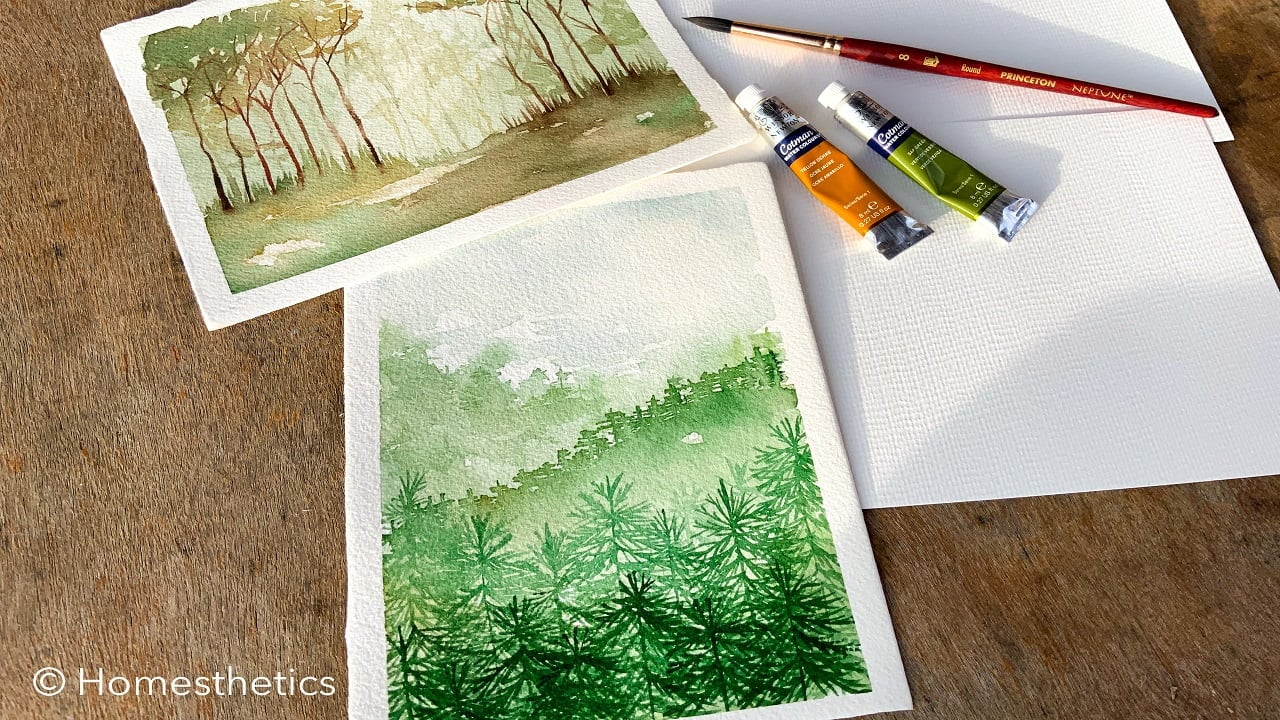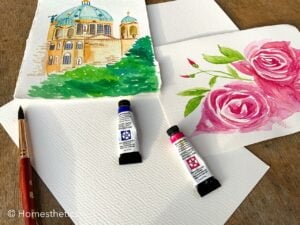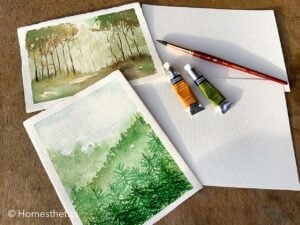To paint on Yupo papers, you need paints, brushes, water, and masking tape. Before you begin painting, it is crucial that you clean your paper and then prime it (optional). There are various techniques that you can use to apply watercolor on Yupo paper, such as pouring and dripping, blending and brushwork, and stenciling and stamping.

If you have ever tried painting methods such as acrylic painting, you must know that the traditional watercolor paper doesn’t do justice to them. Yupo paper is considered to be a great alternative for such techniques of creating art.
The polypropylene fibers of this paper create a smooth and non-porous surface. This finish is ideal for watercolor painting because it allows the paint to sit on top of the paper instead of getting absorbed in it. As a result, you can create more vibrant art pieces using Yupo papers.
In this blog post, we will be taking a look at how you can apply watercolor on Yupo paper easily. We will also discuss the various techniques and materials involved in this process. Let us begin!
Art Supplies Required To Paint On Yupo Paper

1. Yupo Papers
It does not take rocket science to guess the first and the most important material required for Yupo painting - Yupo papers! The non-absorbent surface allows the painter to create a variety of effects using different colors. Moreover, the tree-free paper is available in a range of thicknesses and sizes, and you can choose one according to your preferences.
2. Watercolor Paint
Although you can paint on Yupo papers with a variety of mediums like acrylic paint and alcohol-based ink, it works best with watercolor paint. You should ensure that the set of watercolor paints that you choose to go for are of high quality so that they work well with Yupo papers.
3. Brushes
You will require a variety of decent-quality brushes to blend the watercolor on Yupo paper. There are several round, flat, and thin brushes easily available on the market. Hence, you can buy one according to your landscape painting requirements.
4. Palette
Artists need a good-quality watercolor palette to mix their watercolors. Ideally, you should choose plastic or ceramic palettes that have a decent number of wells. Further, it is best if you go for the light-colored options because they help you stay closer to creating precise shades of colors.
5. Water
Every watercolor artist is aware of the importance of water while making a watercolor painting - and this case is no exception. Ensure that you have a jar of clean water by your side to clean your brushes and avoid any form of muddiness.
Additionally, water helps artists dilute the intensity of pigmentation on their brush. Hence, if you want to create a lighter hue on your Yupo paper, you should have a mug of water by your side to dip your brush in!
6. Masking Tape
It is best to use masking tape around your Yupo paper and secure it to your board. This will help you keep your painting surface still in a comfortable position while you create beautiful art on it.
How To Prepare For Yupo Paper Painting?
Yupo paper is synthetic, and hence, you need to prepare it before you begin working on it. Here are two steps that you need to follow to prepare your Yupo paper:
Preparing The Yupo Paper For Painting
1. Cleaning The Surface
You must use a clean surface for painting. The Yupo paper should not have any dust or dirt accumulation on its surface, which is why it is advised to clean it before using it. Use a soft dry brush or a lint-free cloth to gently clean the paper.
2. Priming The Surface
The next step in preparing your Yupo paper is priming its surface. However, the method of priming that you choose to go for depends on what kind of paint you will be painting with. Some of the most common types are listed as follows along with how you can prime your Yupo paper accordingly:
A. Watercolors
Take equal parts of water and rubbing alcohol and mix them. Transfer the mixture solution to a spray bottle and spray a layer of the mix over the surface of your Yupo paper. Ensure that the paper is not saturated in the solution, or else it might warp. Let it dry before you begin painting.
B. Acrylics
If you want to paint with acrylics, you should prime the Yupo paper using acrylic medium and water. Mix one part acrylic medium with three parts water. Dip a brush in this solution and give the paper a quick wash. And let it dry.
C. Oils
Before using oil pastel or paints, it is best to prime the sheet’s surface with an oil-based primer first. It will create a stable surface, which is much easier to paint on. Simply apply the primer on the paper using a brush (or a roller). Let it dry completely, and then begin oil painting!
Tips For Priming The Yupo Paper
While priming the surface of Yupo paper is not a difficult task, there are a few tips that you should keep in mind. Doing so will help you prevent any wear and tear to your paper, and help you bring out the best priming results. Some of them are listed as follows:
- Use a fine mist while spraying the primer solution over your Yupo paper instead of a heavy mist.
- Test the primer on a small scrap of Yupo paper first to avoid any unwanted effects.
- Whenever you use a brush to apply the primer on Yupo paper, ensure that you use a light touch because it can get damaged very easily.
- While you should consider sticking to white primers for better visibility of colors, you can choose other color options depending on the hue you wish to provide your painting with.

3 Techniques For Painting On Yupo Paper
1. Pouring And Dripping
If you want to create abstract designs on Yupo paper, it is best to use the pouring and dripping technique. To do either (or both) of these techniques, you first need to collect the necessary art supplies like paints, palettes, brushes, pouring cups, and so on.
To prepare your paints for pouring, aim for a consistency that is somewhere between medium and thin . Next, pour this mix on your Yupo paper. Tilt the paper at different angles to allow the wet paint to blend organically. You can also use a brush to create the desired effect using the poured paint. This technique is usually used to create effects like the waterfall effect.
Many artists like combining pouring with dripping. To do the latter, all you need to do is drip a little bit of paint on the paper. Let it mix with other colors by tilting the paper, or use a brush to create desired effects.
2. Brushwork And Blending
You can never go wrong while using traditional painting techniques, and brushwork and blending fall into the same category! Since Yupo paper does not absorb the paint applied on its surface, you will have ample time to blend and work with colors.
To carry out this technique, take your choice of paint. Add a small amount of water in it to bring it to a thinner consistency. Next, use a brush to apply this color on your Yupo paper.
You can then easily blend the different shades in layers and create a variety of effects using different types of brushes or your finger. There are several tutorials on YouTube that you can refer to for this step.
3. Stenciling And Stamping
Sometimes, all your painting requires is a little depth. Stenciling and stamping are popular techniques to achieve this goal. Both of them are used to create designs and patterns in artworks.
For stenciling, place the stencil on your Yupo paper. Next, using brushes or sponges, apply paint on the open spaces of the stencil. Once you are done adding the colors, lift the stencil carefully, and voila! Your designed image is created.
Stamping is another easy process that you can use to create repeated patterns. Dip your choice of stamp into the paint and press it onto the Yupo paper.
Tip
Repeating the stamping process multiple times can help you create different patterns and designs.
More Tips And Tricks For Working With Yupo Paper
1. Using A Mister Or Spray Bottle To Wet The Surface
While the non-porous property of Yupo paper is beneficial in many ways, there is a major downside to it - difficulty in controlling water and paint flow. Hence, it is a good idea to wet certain sections of the paper for better results.
Using a mister or spray bottle to spray water on Yupo paper can allow you to create a large variety of effects, such as color runs. Such bottles also let you control the amount of water applied to the paper. As a result, the paper does not get saturated and warped.
2. Allowing Each Layer To Dry Completely Before Adding Another
If you are using a lot of water and paint while painting on your Yupo paper, it is best to allow each layer to dry completely before adding another. This is also a recommended process for other forms of painting, such as using watercolors on wood.
Since synthetic papers take longer to dry out as compared to traditional watercolor paper, adding layers onto a wet surface can lead to possible wear and tear.
Further, adding another layer of paint or water before the previous one has dried out can also lead to muddiness and unwanted effects. If you can’t wait long enough to let the paper completely dry out naturally, you can use a hair dryer, clothes dryer, or heat gun to speed up the process. However, you should be careful while doing so because excessive amounts of heat exposure may damage the paper.
3. Experimenting With Different Media, Such As Acrylics Or Alcohol Ink Art
Yupo paper is compatible with different media, such as watercolors, acrylics, and alcohol-based inks.
For instance, using acrylics on Yupo paper is a great idea. You can either dilute them with water for a watercolor effect or use them straight out of the tube for a bolder punch. Similarly, alcohol inks can be used to add different kinds of textures to your painting.
It is best if you can use a combination of different media (mixed media) to discover what suits best with your style. Experimenting with them on Yupo papers can help you unleash and broaden the horizons of your creativity.
4. Use A Palette To Mix Colors
If you like complete control over the intensity and consistency of your paints, it might not be a good idea to mix colors directly on your Yupo paper. It is always advised to use plastic color palettes to mix your colors before you begin painting. This way, you can ensure that the consistency of paints and intensity of pigment are exactly as you need them to be.
Traditional art papers are known to be absorbent due to their high porosity levels. This means that when we apply paint on their surface, the fibers of such papers soak the paint in. As a result, the paint dries out quickly, leaving less room for creating unique designs and textures. On the other hand, Yupo paper is a synthetic paper made up of 100% polypropylene. It is also water-proof and stain-resistant, so you can explore your creativity and experiment as much as possible. It is best to stick with non-water-based media. Acrylic inks and paints, alcohol-based inks, and oil paints are a few of the many options that you can choose to go for when creating paintings on Yupo papers. Yes, you should prepare the Yupo paper before you begin painting it. The first step of this preparation should be cleaning the paper to remove any debris or dirt accumulation from its surface. You may prime the paper for better results. To do so, apply a suitable fluid primer on the Yupo paper depending on the kind of paint that you will be using to paint. You can also lightly sand the paper so that your paint can stick better. These steps of preparation are optional, but the first step – cleaning – is a necessary step of preparation. Using watercolor painting techniques on Yupo paper can be quite challenging. However, there are certain watercolor techniques that you can try out on Yupo papers. For instance, you can layer using different paints to create a variety of layers in your artwork. You may also try out the method of lifting, which requires you to lift paint off the surface using a damp brush. The best way to control the flow of the paint on Yupo paper is by using a spray bottle. Fill your spray bottle with a decent amount of water. Use it to spray the water on the desired section of your painting where you want to control the flow of paint. There are various ways through which this process can help you control the flow of paint on your paper. For instance, once you spray water on the Yupo paper, you can tilt your painting in different angles or directions to let the paint flow naturally. Similarly, you may also use the techniques of manipulating the surface or use gravity to facilitate the flow. Yes, you can easily lift or remove paint from these papers even after it has dried out. To do so, take a cloth or paper towel and dampen it. Next, use it to scrub off the paint from the paper gently. You can also dab the paint off of the surface. It is important to note that excessive moisture or pressure can potentially damage the surface of your Yupo paper. Hence, it is crucial to use a light touch. While painting on smooth surfaces, it is best to go for flexible brushes. After all, you need to have good control over your strokes to create your desired effects and textures. A soft synthetic brush is a great option to go for while painting on Yupo paper. You may also go for a natural hair brush since it is easier to paint with it on a smooth surface. Yes, you can use other materials like India ink, markers, or pencils. However, different tools will have different effects on the paper depending on various factors. For instance, ink can be used to create vibrant and bold components of your painting. It is translucent and smooth and blends amazingly. The effect of markers will depend on the type of marker used and the texture of your Yupo paper. The best way to protect your finished Yupo paper painting is to keep it away from sunlight. The UV rays of the sun turn the white Yupo paper into yellow, which can damage the overall quality of your painting. Similarly, you should store your painting away from moisture after waterproofing it. You can frame your Yupo paper painting just like a traditional watercolor paper artwork. This will ensure that contaminants like dust and dirt do not accumulate on your painting. Hence, your artwork will stay protected and last for a long time. Yes, these papers can be used for other art techniques besides painting. For instance, they can be used for printmaking to create monotype prints. Artists like using Yupo papers for collage-making too. They stick a variety of tissues, photos, or clippings throughout the paper. This is because it is durable enough to stand the adhesive that is applied to it. Since you can use graphite, charcoal, or watercolor pencil on it, Yupo paper is also used for drawing. FAQs Related To Painting On Yupo Paper

Conclusion
Yupo paper is a unique innovation in the field of art. It is a 100% polypropylene synthetic paper that is completely non-absorbent and non-porous. The various advantages of using this paper include a smooth surface to paint on, paints not drying out quickly, and versatility.
You can easily apply watercolor on Yupo paper by preparing it first. Clean any dust or dirt that may have collected on your paper. You can also prime its surface for better results. Then, you can use techniques such as pouring and dripping, blending, stenciling, brushing, and stamping to create paintings.
The Yupo papers allow artists to have as much fun as they want. The versatility and functionality of this paper can let you do anything from drawing to painting and creating collages.
So, let your creativity drive you to experiment with the various painting techniques on Yupo papers!
